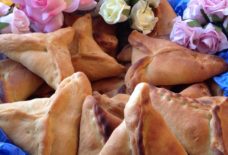A Dessert Drink to Warm Up Your Winter: Sahlab
By: Blanche Shaheen/Arab America Ambassador Blogger
For many, drinking coffee is a ritual that comforts all of the senses, especially on a cold, wintry day. The sound of the percolating espresso machine triggers excitement for the energizing drink to come. The warmth of the coffee cup defrosts brisk fingertips. The flavor is tailored to each person’s preference – rich cream, a sweetener of choice, perhaps a touch of cocoa or spicy cinnamon. The elements of sound, smell, touch, and taste work in tandem to transform a simple drink into an all-encompassing experience that many require to start the morning.
While Arabic coffee is popular in the Middle East, there is a hot, sensuous beverage that gives coffee serious competition – sahlab (also known as salep). A cup of sahlab is sweet, warm, spicy, creamy, crunchy, chewy and fragrant all at once.
The word “sahlab” refers to a white, starchy powder ground from the dried roots of wild orchids found in Morocco, Afghanistan, Greece, Cyprus and, most abundantly, Turkey. Not surprisingly, it was the Ottoman Empire that introduced sahlab to the Middle East, where it has been a staple in cafes and street stalls in Levantine countries for centuries.
The sahlab root powder gives warm beverages, puddings, and even ice cream a thick, almost fluffy texture with an intoxicating floral scent. The root is rich in protein and calcium and has a thickening quality like cornstarch to make the drink as white and creamy as whole milk. The drink has been touted to improve circulation, cure stomach ailments, strengthen bones and teeth – and, dare I say, act as an aphrodisiac.
Sahlab powder is difficult to find, as the flower is in danger of extinction – importing true sahlab is illegal. However, I have found that combining rose flower water with milk mimics the flavor of sahlab very well, with similar nutritional benefits. Rose flower water is relatively inexpensive and easier to find, with the modern supermarket giving us many choices of milk to suit our dietary needs. I have made sahlab with almond, hemp, flax, coconut and even cashew milk with great results.
While most sahlab recipes call for 1 cup sugar, I find that 1/3 cup is plenty to impart a nice, sweet flavor. Feel free to use any sugar substitute you wish. What really makes sahlab stand apart from other beverages such as coffee are the toppings – coconut, pistachios, and cinnamon. Sahlab is a drinkable dessert that you can enjoy guilt-free.
My mother’s favorite memory as a child was enjoying a cup of sahlab in a cafe in Bethlehem after attending Mass at the Church of the Nativity. I may not be able to travel that far anytime soon, but I can certainly create my own memories with my customized cup of sahlab.
To watch Blanche’s video Tutorial before attempting the recipe see below.
Recipe for Sahlab
• 1 teaspoon rose water or orange blossom water (use more if you like the flavor)
• 3 tablespoons cornstarch
• 1/3 cup sugar
• 4 cups milk (either regular or dairy-free milk of your choice), divided
• Cinnamon
• 1/3 cup coconut, shredded • 1/3 cup pistachios, finely chopped
Stir cornstarch into 1/2 cup of milk until dissolved and set aside. Bring remaining milk and sugar to boil in a saucepan, lower to simmer and stir to make sure that sugar dissolves.
Add cornstarch mixture to heated milk in a saucepan. Simmer 10 minutes over low heat, stirring constantly to keep lumps from forming. Add rose water, stir again and serve in small cups.
Sprinkle each serving with 1 rounded teaspoon each of pistachios and coconut. Dust with cinnamon and serve immediately.
Makes 8 small cups or 4 larger cups.
Blanche Shaheen is a journalist, food writer, and host of the cooking show called Feast in the Middle East. She specializes in Arab cuisine of the Levant and beyond You can check out her cooking video tutorials and cultural commentary on growing up Arab American at https://www.youtube.com/



